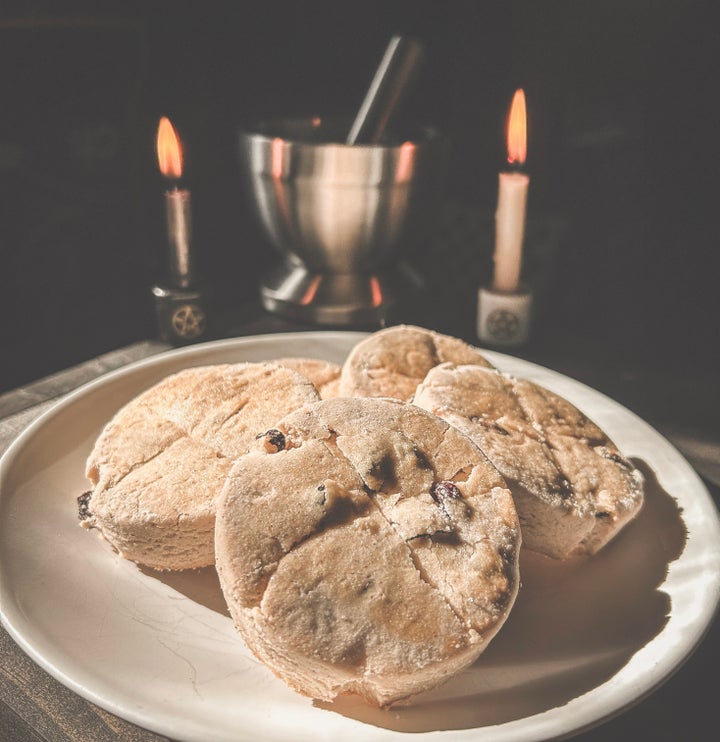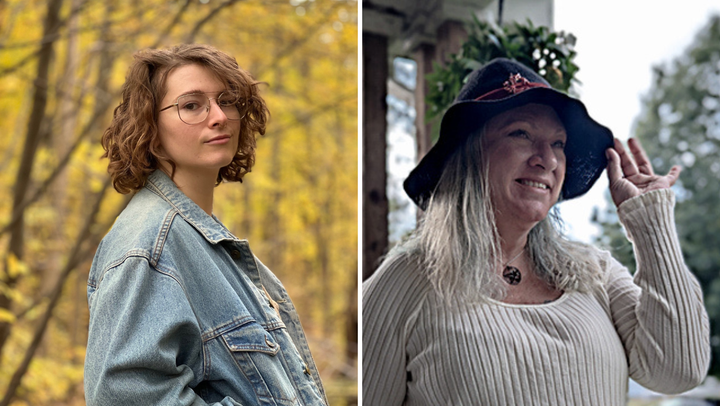Hint: It’s not candy corn. There’s profound meaning in the foods these practicing witches eat on the holiday.
Most of us are content to stuff ourselves with candy and anything pumpkin spice on Halloween, but many who actually practice witchcraft have rich and varied traditions surrounding food on the holiday (which many witches refer to by its ancient Gaelic name, Samhain).
“For Samhain, the connection between cooking and eating and magic is very strong,” said Raechel Henderson, a Witchcrafter and author of “The Natural Home Wheel of the Year: Crafting, Cooking, Decorating & Magic for Every Sabbat.”
“We mindfully prepare our offerings as a form of devotion and reconnecting with those who have passed beyond the veil,” said Sophia Rose, an eclectic witch, referring to the separation between the earthly plane from the spirit world. “Food and drink are potent vessels for magical energy and intention” and they “are profoundly magical on Samhain,” Rose explained.
Ashley Seekraft, a traditional Gardnerian witch, explained that many witches believe Samhain is the “time of the year when the ‘veil between the living and the dead’ is the thinnest,” which makes Samhain “an ideal time to “celebrate and honor deceased loved ones,” often with rituals involving food.
We asked several practicing witches to share their Samhain food traditions with us.
Some eat special Sabbat cakes.
Aubrianna Myers, a kitchen witch who is a priestess of the Cabot-Kent Hermetic Temple, makes special Sabbat cakes on Samhain. She describes these cakes as “a cross between a biscuit and a scone” using “seasonal spices such as cinnamon or nutmeg and clove, paired with wine, ale, or fresh cider.”

Aubrianna’s husband, Jason Myers, a Priest in the Cabot tradition, explains that during many religious pagan ceremonies “cakes and ale” are offered to a deity. However, during Samhain, Sabbat cakes and other offerings are made to “ancestors and spirits who have crossed over.” Jason explained that “we take those offerings outside, set a portion of the food out for the gods and spirits that we work with, and pour a libation into the earth.”
Food is used to connect with ancestors.
During Samhain, Seekraft makes some of her deceased Puerto Rican grandmother’s specialties, including arroz con pollo or arroz con dulce. “It’s a great way for me to connect with her,” she said.
When Seekraft is cooking these dishes, she “blesses the salt and spices” and talks to her grandmother “out loud, as if she were in the room with me.” Sometimes, Seekraft makes an elemental pentagram with her spoon in the pot as she is cooking to “call the spirits into my space,” she said.
Pomegranates are sacred.
Lex Ritchie is an animist folk witch and spirit worker who performs several rituals with pomegranates on Samhain. To Ritchie, pomegranates represent the myth of Persephone, the goddess of the harvest who was forced to take on the role of queen of the underworld after eating pomegranate seeds.
On Samhain, Ritchie makes pomegranate oxymel, a mixture of honey and vinegar, using a secret recipe. She also slowly eats a pomegranate slice while spending time “at the altar in connection with my ancestors,” who came from Southern Italy, where pomegranates are abundant in fall.
Finally, on Samhain, Ritchie places a whole pomegranate on her altar and leaves it there throughout the winter. “The pomegranate holds the prayers I have prayed to my ancestors,” she said. In the spring, Ritchie buries in the pomegranate in her garden.
They find enchantment in fall foods.
On Samhain, Henderson leaves more food than usual on her altar for “the various spirits that stop by.” She also cooks with warming spices like cinnamon and clove as “a reminder that it’s now time to rest.”
However, Henderson finds her practice enriched by Halloween customs that have little to do with her own faith tradition. “Samhain is one of those times of the year when it is easier for me to incorporate my practice into my everyday life because the food is redolent of magic, from candied apples and Halloween candy to roast dinners and apple cider,” she said. Henderson adds that “all of it reminds me that enchantment is everywhere.”

They eat the “bones of the dead.”
Dee Norman, who practices traditional Italian folk magic and witchcraft, says that “a large part of our practices involve kitchen magic,” including “making food that is delicious and protects, strengthens and blesses family and friends.”
For Samhain, Norman makes ossi dei morti, or “bones of the dead,” cookies. The cookies are flavored with almond and lemon and shaped into bones. Norman leaves some cookies on her altar to share with her ancestors, and her family eats the rest.
“The ossi dei morti are a special way to commemorate the ancestors’ passing and include a special Italian dish in our celebrations,” Norman explained. On Samhain, Norman also prepares foods her loved ones who have passed away enjoyed as a way to feel closer to them. “It’s just like planning for a party for your living relatives…I try to be considerate and think of what visiting ancestors might enjoy,” she said.
They eat pumpkins.
On the night before Samhain, Rose bakes pumpkin bread to share with her coven. “Pumpkin symbolizes wisdom and insight, perfect for honoring our ancestors and the turning wheel of the year,” Rose explained.
As she bakes, Rose chants an incantation to “imbue the bread with protective energy.”
On Samhain, Rose also drinks “a potent cup of spiced black tea, with cinnamon, clove and nutmeg, to aid in divination and communication with spirits during rituals.” Rose explains that the “fragrant steam from the tea helps open psychic senses.”
They hold a “Dumb Supper.”
Jennie Koper, a solitary witch, said that Samhain is a somber day. Among other Samhain rituals, Koper cooks pumpkin ravioli in brown butter and serves it during a “Dumb Supper,” which is eaten by candlelight without speaking. During the Dumb Supper, Koper sets places at the dinner table for friends and family who have passed. At each empty spot at the table, Koper sets out a small meal for spirits who might visit “as an offering.”
Then, “we dine in silence and in the dark, remembering our loved ones,” she said. At the end of the meal, Koper’s family shares “a memory or two about those who have gone before us. The silence is a welcome reprieve from the busyness of Samhain, and the memory sharing tends to carry on the rest of the night,” she explained.
Koper, who also hands out candy, holds tarot readings, and hosts a party for her child’s friends on Halloween, said, “Even with all of the busyness, I think it is super important to take a few moments and honor those who have gone before us.”
Some have a “Devil’s Dinner Party.”
Shiva Honey is a Satanic witch and priestess within the Satanic Temple. To mark Samhain, Honey hosts a “Devil’s Dinner Party” catered by her friend and Satanic chef Adam Dodge Ostrofsky.
Honey describes these parties as “multicourse, surrealist, immersive dinners.” During the dinner, cell phones are banned and guests are blindfolded as they enter. “I guide each guest by hand to the dinner table and sit them as music plays. The first course is eaten blindfolded so that the guests are fully immersed in the experience and their sense of taste can be amplified,” Shiva explained.
The food served at Samhain Devil’s Dinner Parties is “inspired by traditional Samhain dinners” and includes pumpkin soup “to represent the jack-o-lanterns in modern Halloween traditions,” Honey said.
Credit: Source link